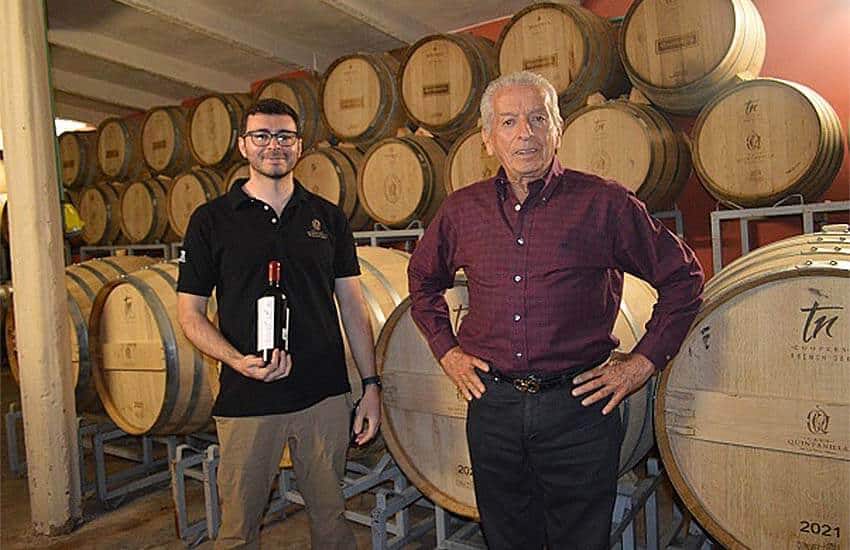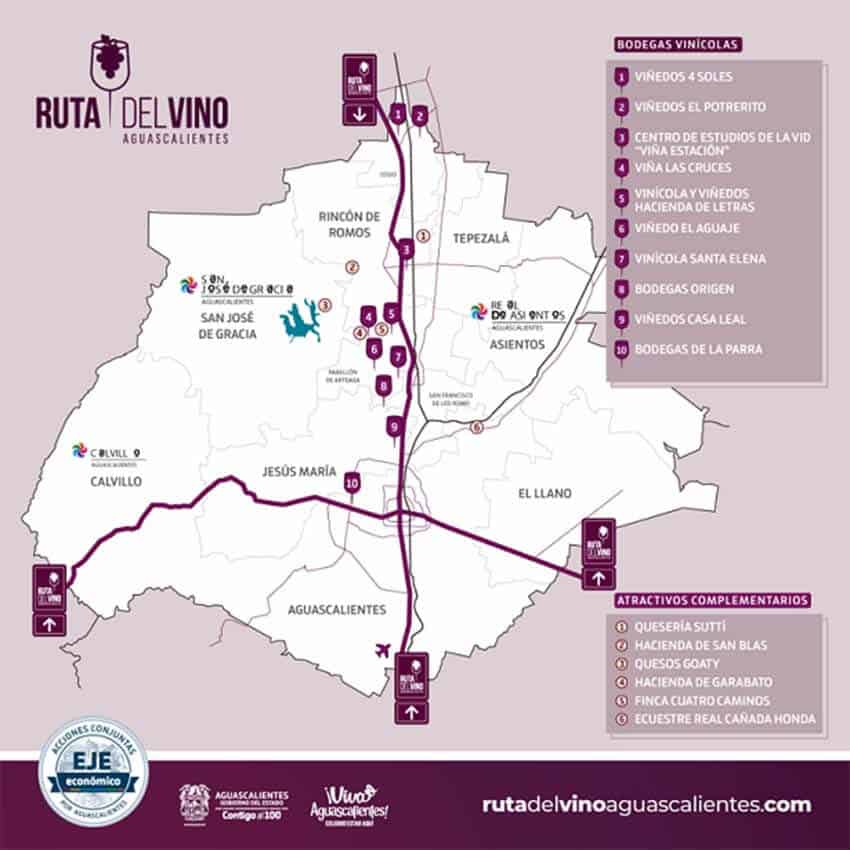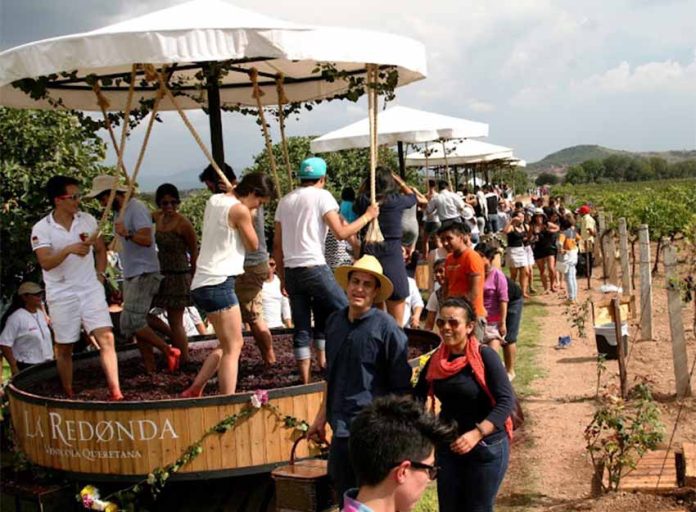It is grape harvest season (vendimia) in Mexico, and while the wines of northern Baja have had almost all the attention for decades, its successor could be the Bajío winemaking region.
A loosely-defined region in central Mexico based on geographic, historical and economic factors, the Bajío’s heart is in the states of Guanajuato and Querétaro, but it extends into parts of San Luis Potosí, Aguascalientes, Zacatecas, Jalisco and Michoacán — how far in each is somewhat disputed. And most of these states are producing wine.
Wine grapes were introduced early here by Mexico’s colonizers, but the Spanish crown forbade commercial wine production in Mexico as a protectionist measure. It would be centuries before the country developed a winemaking industry.
In recent years, significant wine production developed in all of the Bajío’s states, minus Michoacán, and these days, such wines are categorized as “Bajío” wines.

Why did Baja develop its wine country first? The Bajío developed theirs later than Baja because of its location — south of the 30th parallel the southern edge of most wine grape cultivation in the northern hemisphere. But varying altitudes and other factors create microclimates that are indeed ideal to winemaking.
The development of a wine industry in the Bajío region is due in large part to the saturation of Baja’s agricultural areas, as well as the continued growth of Mexico’s wine consumption providing more business opportunities. Baja remains by far the most famous wine region, but an increasing number of Bajío vineyards have gotten the attention of the Mexican press and beyond: this month, the Washington Post newspaper did a story principally on Guanajuato wines.
However, it’s Querétaro, not Guanajuato that currently has the Bajío’s most developed wine industry, dating back to the first vines planted by La Redonda winery in 1972. Ten years later, the Spanish sparkling winemaker Freixenet began producing here, becoming the largest vineyard in the state — so dominant that for many years, Querétaro wine was thought to be almost exclusively sparkling white.
But these days, there are now more than 30 vineyards in 11 southern Querétaro municipalities producing a variety of wines.
Neighboring Guanajuato came later in the game, but its industry has grown quickly: it now has a similar number of wineries whereas a decade ago only three existed. This state’s wine area stretches from the town of Comonfort northward through San Miguel de Allende and into Dolores Hidalgo and San Felipe, plus a few near the state capital.
A number of wineries here promote themselves as “natural wines,” meaning that they eschew one or more modern growing or processing techniques.
Wine production in the other aforementioned states is more of an emerging industry: Aguascalientes has long grown grapes — mostly for fruit and juice sales, although experimentation with winemaking began in the 1990s. Early wineries were established in the 2000s, including the state’s best-known, Santa Elena. Wine production is concentrated almost due north of the city of Aguascalientes in the Cosío, Rincón de Romos, Tepezalá and Jesús María municipalities.
Zacatecas’s producers are scattered over various municipalities outside the state capital, with many located more than 2,000 meters above sea level. Wineries here include Tierra Adentro, Vinos Cacholá, El Cosuelo, La Casona and Luévano Ruiz. Campo Real in Trancoso has a Barrel Museum (Museo de la Barrica), the only one of its kind in Mexico.

Wine production has also touched the extreme west and east of the region in San Luis Potosí and Jalisco, perhaps not surprising since these states all border each other. An area west of San Luis Potosí is so promising that in the early 2010s, it began attracting the attention of world-class oenologists such as Argentine Matías Utrero of Cava Quinantilla winery.
In Jalisco, producers are in the Los Altos region and even Talpa de Allende (a coffee-producing area), but the buzz here is all about the microclimate on Lake Chapala’s south shore.
The first grapes in the state were planted at Viñedos El Tejón by Serapio Ruiz decades ago after he returned from working vineyards in Napa Valley. He has helped just about everyone in the area since then.
Yet, despite the attention Jalisco has received, the hills here are not yet covered in grapevines. It will be some time before the area lives up to the hype of billboards here selling homes in Jalisco’s “wine country.”
A mature wine industry sprouts wine tourism, which is probably why Querétaro is the only state with a well-developed winery tourism industry right now, helped by Freixenet’s many years of public tastings and public tours. Wine festivals here began decades ago as well.
The heart of Querétaro’s wine tourism is its state-sponsored Art, Cheese and Wine Route, which makes it easy to find, visit and tour vineyards, as well as cheese producers and other attractions. The route generates about 4 billion pesos of income each year.
Guanajuato has a smaller wine route, centered on a wine museum in Dolores Hidalgo. This route has the advantage of being easily accessible to the large expat and weekender population in San Miguel de Allende, which has seen a surge in wine bars that promote locally and regionally produced wines.
But besides in these two states, such tourism in the Bajío is, at best, in its infancy.
Zacatecas, Jalisco and San Luis Potosí lack any kind of viable wine routes, and Aguascalientes has only just set one up. My recent visit to San Luis Potosí was somewhat frustrating as the state tourism page provided no contact details, and I got no answer calling the one local tour company I found.
Fortunately, I connected with Cava Quintanilla, which happily received me, but their tours typically are by group reservation only, and they are still working on building a restaurant and lodging facilities.
Wineries in the Lake Chapala area of Jalisco are difficult-to-impossible to visit. Many are closed to the public, and some are just simply inaccessible due to poor roads. One positive step in this direction, however, is the very recent opening of Quinta Fabiana in San Cristóbal Zapotitlán, a boutique hotel with its own exclusive wine.
Outside Querétaro, the best way to visit wineries is through tour companies. These are still in development and tend to be local, but some can be found through internet searches and travel agencies.
Lists of wineries holding harvest celebrations with dates can be found at these websites:
Leigh Thelmadatter arrived in Mexico 18 years ago and fell in love with the land and the culture in particular its handcrafts and art. She is the author of Mexican Cartonería: Paper, Paste and Fiesta (Schiffer 2019). Her culture column appears regularly on Mexico News Daily.
